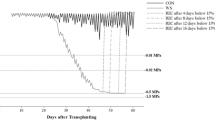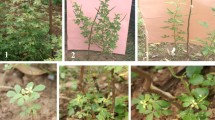Summary
The indigenous white clover (Trifolium repens) ofFestuca-Agrostis pastures in S. Scotland is shown to be characteristically small leaved, prostrate and of small diameter in comparison with the cultivar S184. Within the indigenous type, leaflet size was found to be differentiated in relation to soil base status. This was attributed to the effect of grazing intensity which in these pastures varied with soil base status.
Similar content being viewed by others
References
Harberd, D. J., The case for extensive rather than intensive sampling in genecology. New Phytol.60, 325–338 (1961).
Holding, A. J. and King, J., The effectiveness of indigenous populations ofRhizobium trifolii in relation to soil factors. Plant and Soil18, 191–198 (1963).
Snaydon, R. W., Population differentiation inTrifolium repens. Ph.D. Thesis, University College of N. Wales (1961).
Author information
Authors and Affiliations
Rights and permissions
About this article
Cite this article
King, J. Ecotypic differentiation inTrifolium repens . Plant Soil 18, 221–224 (1963). https://doi.org/10.1007/BF01347876
Received:
Issue Date:
DOI: https://doi.org/10.1007/BF01347876




